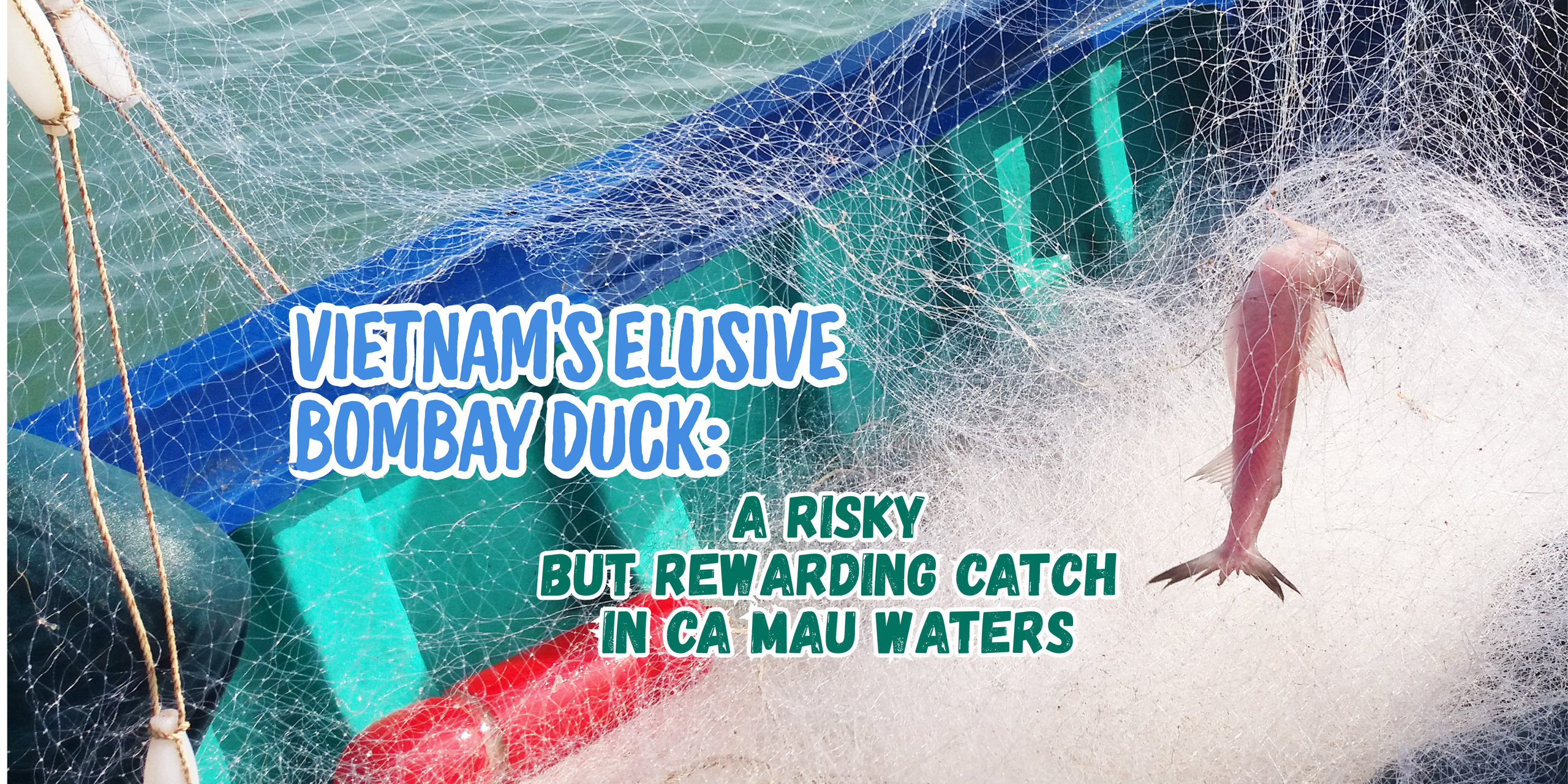Please enter Email
Email Invalid Format
Please enter your Full Name.

Before dawn breaks over the southern coast of Vietnam, 51-year-old Kim Van Thang is already wide awake.
At 4:00 am, he straps a headlamp to his forehead, grabs a basket of freshly cooked rice and fried salted fish—his breakfast and lunch for the day—and calls to his sleepy 20-year-old son to join him on their narrow wooden boat.
Together, they head toward the open sea, slicing through the dark, choppy waters off a coastal hamlet near the Go Cong estuary in Cai Doi Vam Commune—formerly Nguyen Viet Thai Commune in Phu Tan District before a recent administrative merger—in Ca Mau Province.
Their destination: a secretive, seasonal fishing ground that is home to the elusive and highly prized ca khoai, or Bombay duck.
The journey is perilous.
Their small motorboat bucks with the waves, the propeller alternately whirring above and below the waterline.
There is no compass—just stars and instinct.
“I’ve been doing this for years,” Thang said as he was steering through the pitch black.
“I know where the nets are, where the reefs are, and how to find the ca khoai ground.”
By the time the horizon turns grey with the approaching dawn, Thang and his son arrive offshore where dozens of other boats have already anchored across a five-square-kilometer stretch of sea.
Some are just arriving, others are already casting nets.
Thang's five-meter-long boat holds about 1,200 meters of net—weighted on one edge, buoyed on the other to float vertically underwater.
As the boat glides ahead, his son tosses out a warning float tied to the first end of the net, then unspools the mesh behind them.
Once the net is set, they let the boat drift.
Thang lights a cigarette and tucks into his rice, while his son catches a few minutes of sleep.
The father keeps a sharp eye on the sky.
"It looks calm now, but clouds can roll in quickly. You have to be ready to pull the net if a storm hits," Thang said.
After two hours, they haul in the net—each man at one end, pulling steadily, removing the fish as they go.
The first catch yields nearly 20 kilograms of Bombay duck, enough to meet their goal for the morning.
On a good day, they only need one drop of the net before heading home. At most, they will do two.
"You have to sell ca khoai the same day, or the price drops fast," Thang explained.
"They don't keep well, and if we come back too late, we have to salt them.
"That cuts the price in half."
The Bombay duck is not just delicate to handle but it is also famously unpredictable.
Locals say it has 'odd habits' that make it especially hard to catch.
But during a short season from just after the Lunar New Year until the onset of the monsoon, usually late May in the lunar calendar, the fish appear in dense numbers in specific offshore areas known to locals as 'ham ca khoai,' literally translated as 'Bombay duck chambers.'
They only surface during particular tidal days: around the full moon, or 14th to 17th of the lunar month, and the new moon, from 29th to second.
On off days, even the most experienced fishermen catch barely a kilogram or two.
No one knows exactly why.
Fishermen haul Bombay duck nets off the coast of Ca Mau Province, southern Vietnam. Photo: Thanh Huyen
Some, like veteran fisherman Nguyen Van Vu from Dat Mui Commune, believe it is because these periods are their spawning season.
Others point to water conditions—these 'chambers' often sit at the meeting point of clean sea currents and murkier freshwater flows, creating ideal salinity and temperature.
Each year, the fish return to the same handful of spots.
If the sea is rough, the fish come in larger numbers.
The seabed here is dotted with coral and sunken wood where the fish shelter.
Once the season ends, they vanish completely.
Despite the scarcity, locals fish sustainably.
They use large-mesh nets that do not trap juvenile fish.
And within the Bombay duck zones, boats self-regulate, preventing trawlers or drag nets from entering.
Freshly caught Bombay duck on a boat off the coast of Ca Mau Province, southern Vietnam. Photo: Thanh Huyen
A successful season can bring in thousands of dollars for each small boat.
But the risks are real.
Coral snags can tear expensive nets, wiping out a family’s savings in one mistake.
And because most Bombay duck boats are small, a sudden storm can mean capsizing—or worse.
“Bigger boats with sonar and winches do better,” says Tran Van Toan, a fellow fisherman.
“They can stay out longer in rough seas.
“One day, I hope to afford a boat like that.”
When fish are plentiful, fresh Bombay duck sells for about VND40,000 (US$1.5) per kilogram.
On rare days, prices can triple.
The sun-dried version—chewy, slightly sweet, and rich in flavor—sells for VND500,000-700,000 ($19–27) per kilogram and is a favorite among gourmets.
For now, Thang and his son will keep returning to the sea, reading the stars, and hoping the fish return—just as they have for generations.
Please enter Display Name
Please enter Email
Email Invalid Format
Please enter Email
Email Invalid Format
Incorrect password.
Incorrect login information.
Account locked, please contact administrator.
An error occurred. Please try again later.
Max: 1500 characters
There are no comments yet. Be the first to comment.